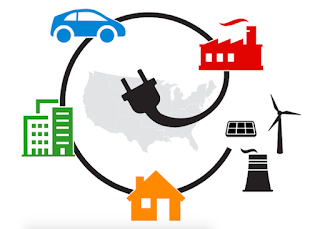While coal stakeholders were still reeling from that double whammy, yesterday NREL introduced a companion report aimed at smoothing the way for more variable renewable energy — primarily wind and solar power — in the national grid.
...
Paving The Way For An All-Electric Future
Where were we? Oh right, that new electrification study from NREL. This comes under the title, “Electrification Futures Study Series,” so it’s going to be a long, dry slog. However, it sets an important foundational table for what looks to be a soup-to-nuts transformation of the nation’s grid.
The idea is to model how the grid will act when electricity becomes the major force in all areas of the economy. That generally involves pushing natural gas aside in residential and commercial buildings, giving coal and diesel the heave-ho in the industrial sector, and reducing the role of conventional diesel, gasoline, and jet fuel in transportation.
The initiative will be a two-year effort by NREL in collaboration with top research institutions: the Electric Power Research Institute, Lawrence Berkeley National Laboratory, and Oak Ridge National Laboratory.
The researchers have their work cut out for them if they’re going to wrap up in two years. They have to come up with an answer for this question:
What end-use electric technologies are available for the highest energy-consuming services today, and how might the technologies advance over time?And this one:
How might widespread electrification impact national and regional electricity demand and consumption patterns?And these two:
How would the U.S. electricity system need to transform to meet changes in demand from an electrified economy?
What role might demand-side flexibility play to support reliable operations of a clean electricity grid?If you want more details, check out the first report in the study dealing with heat pumps and electric vehicles.
What are potential costs, benefits, and impacts of mass electrification?
If all goes well, the study will provide policymakers and other stakeholders with tools to help plan for the costs and fuel types needed to ensure grid reliability, economic development and national security.
...
That’s all kind of energy neutral in terms of power generation, and that’s where the second NREL announcement comes in. On Tuesday, NREL let loose with a set of recommendations for modeling wind and solar grid penetration.
And, this is where things get interesting. The recommendations grew out of another collaboration, between NREL and the Electric Power Research Institute, the US Energy Information Administration, and the US Environmental Protection Agency.
Wait — what? If you know anything about EPA chief Scott Pruitt, that’s like inviting a python to your hamster party. Nevertheless, it seems that EPA was fully on board with the renewable energy exercise. By comparing and contrasting their own modeling methodologies, the collaborators came up with a “more robust” representation for wind and solar in the energy grid of the future.
Next steps include long-term modeling that encompasses the interaction of renewables and energy storage, so stay tuned for that.
Read more at US Renewable Energy Hits the Ground Running After FERC Debacle

No comments:
Post a Comment